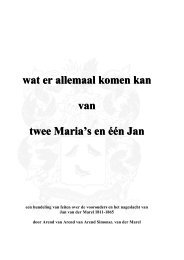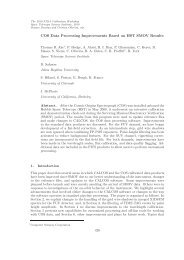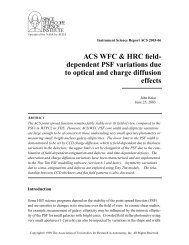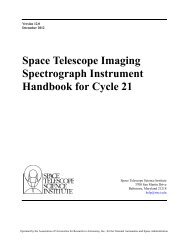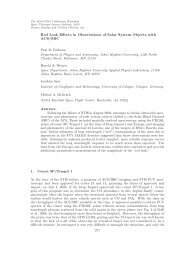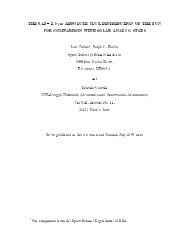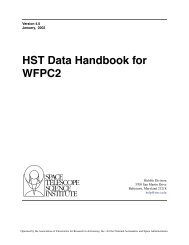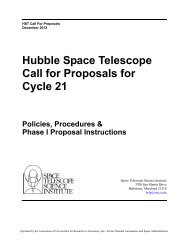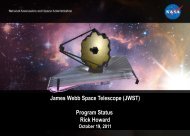STScI Annual Report 2002: A Living Mission
STScI Annual Report 2002: A Living Mission
STScI Annual Report 2002: A Living Mission
You also want an ePaper? Increase the reach of your titles
YUMPU automatically turns print PDFs into web optimized ePapers that Google loves.
18 news<br />
IDTL personnel and detector characterization<br />
system. From left to right: Bernard Rauscher<br />
(project scientist), Ernie Morse (data analyst),<br />
Eddie Bergeron (data analyst), Sito Balleza<br />
(systems engineer), and Don Figer (PI).<br />
Not pictured: Mike Regan (software systems<br />
scientist) and Gretchen Green (detector<br />
head engineer).<br />
Independent Detector Testing Laboratory<br />
— Don Figer<br />
Detectors are at the heart of scientific<br />
discovery, whether as ‘simple’ as<br />
the human eye or as complex as the<br />
sensors on the Hubble Space<br />
Telescope. In recognition of their<br />
importance to astronomy, the<br />
Institute and Johns Hopkins<br />
University (JHU) created the<br />
Independent Detector Testing<br />
Laboratory (IDTL), located on the JHU<br />
campus in the Department of Physics<br />
and Astronomy’s Bloomberg building.<br />
The vision of the IDTL is to provide<br />
world-class testing and development<br />
facilities for astronomical<br />
detectors and associated technology.<br />
While not an easy vision to fulfill, its<br />
success will bring several benefits.<br />
First, the IDTL enables the James<br />
Webb Space Telescope (JWST)<br />
Project Office, instrument teams, and<br />
wider community to select the best<br />
flight detector designs for JWST by<br />
evaluating prototype near-infrared<br />
detectors. Second, the IDTL serves<br />
the astronomical community by publishing<br />
all designs, software, procedures,<br />
raw data, analyses, and publications<br />
on its website, as well as in<br />
appropriate journals. Third, the IDTL<br />
provides the hardware, infrastructure,<br />
and local expertise that enable<br />
Institute and JHU scientists to participate<br />
in forefront space-based and<br />
ground-based astronomy missions.<br />
Lastly, the IDTL trains JHU and<br />
Institute staff, graduate students, and<br />
interns in the design and use of cutting-edge<br />
detector applications, and<br />
this training will ultimately benefit<br />
the development and operation of the<br />
JWST and future missions.<br />
NASA has selected the IDTL to<br />
verify comparative performance of<br />
prototype near-infrared JWST detectors<br />
developed by Rockwell Scientific<br />
(HgCdTe) and Raytheon (InSb). The<br />
IDTL will obtain an independent<br />
assessment of the ability of the two<br />
competing technologies to achieve<br />
the demanding specifications of the<br />
JWST program within the 0.6 to 5 µm<br />
bandpass in an ultra-low background<br />
environment. In this project, we are<br />
measuring first-order detector<br />
parameters—dark current, read<br />
noise, quantum efficiency (QE), persistence,<br />
intrapixel sensitivity, and<br />
linearity—as functions of temperature,<br />
well size, and operational mode.<br />
We have tested a half dozen<br />
prototype JWST detectors during 21<br />
cool-downs of our system. During<br />
these runs, we have established that<br />
the IDTL system is ‘darker’ than the<br />
most stringent requirements for<br />
JWST, verifying ultra-low background<br />
levels of < 0.005 e- sec-1 pixel-1 . This<br />
achievement demonstrates extraordinary<br />
baffling, given that at room temperature<br />
the instrument walls emit<br />
over 1020 photons sec-1 in the instrument<br />
bandpass! In addition, we have<br />
verified low-noise electronics performance,<br />
allowing us to measure<br />
detector noise levels below the JWST<br />
requirements. Our QE measurements<br />
show that candidate detector materi-<br />
als can offer significant response<br />
from blue wavelengths (0.4 µm) to<br />
the desired long-wavelength cutoff<br />
near 5 µm. Finally, we have found<br />
that the detector material can trap<br />
persistent charge, which leaks out in<br />
subsequent images, appearing as a<br />
ghost image of previously observed<br />
targets. Certain detector reset<br />
schemes do appear to ameliorate the<br />
effects of persistent charge.<br />
In the future, we look forward to<br />
enabling detector technology for<br />
other missions, on the ground and in<br />
space, like the Large Synoptic Survey<br />
Telescope (LSST) and the Supernova<br />
Acceleration Probe (SNAP). LSST is a<br />
proposed ground-based, 8-meter<br />
class, wide-field, synoptic survey telescope.<br />
The combined collecting<br />
power and field of view will be much<br />
greater than any existing telescope.<br />
Astronomers will use LSST to survey<br />
large regions of the sky to unprecedented<br />
depth to probe the nature of<br />
dark energy and to detect near-Earth<br />
objects. The IDTL is part of a proposal<br />
to develop the billion-pixel focal<br />
plane for LSST.<br />
SNAP is a proposed spacebased,<br />
two-meter telescope with a<br />
mission to determine the expansion<br />
properties and dark energy characteristics<br />
in the universe. The IDTL is<br />
currently working with the SNAP<br />
team to develop the best nearinfrared<br />
detectors for use in this<br />
ambitious mission. �



